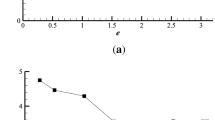Abstract
A fast, flexible, and robust simulation-based optimization scheme using an ANN-surrogate model was developed, implemented, and validated. The optimization method uses Genetic Algorithm (GA), which is coupled with an Artificial Neural Network (ANN) that uses a back propagation algorithm. The developed optimization scheme was successfully applied to single-point aerodynamic optimization of a transonic turbine stator and multi-point optimization of a NACA65 subsonic compressor rotor in two-dimensional flow, both were represented by 2D linear cascades. High fidelity CFD flow simulations, which solve the Reynolds-Averaged Navier-Stokes equations, were used in generating the data base used in building the ANN low fidelity model. The optimization objective is a weighted sum of the performance objectives and is penalized with the constraints; it was constructed so as to achieve a better aerodynamic performance at the design point or over the full operating range by reshaping the blade profile. The latter is represented using NURBS functions, whose coefficients are used as the design variables. Parallelizing the CFD flow simulations reduced the turn-around computation time at close to 100% efficiency. The ANN model was able to approximate the objective function rather accurately and to reduce the optimization computing time by ten folds. The chosen objective function and optimization methodology result in a significant and consistent improvement in blade performance.
Similar content being viewed by others
References
Ahmadi M, Ghaly W (1998) Aerodynamic inverse design of turbomachinery cascades using a finite volume method of unstructured meshes. Inverse Probl Eng 6:281–298
Daneshkhah K (2006) Aerodynamic inverse design of turbomachinery blading in two-dimensional viscous flow. PhD thesis, Concordia University, Mechanical and Industrial Engineering
Dang T (1995) Inverse methods for turbomachine blades using shock-capturing techniques. AIAA paper 1995-2465
Deb K (2001) Multi-objective optimization using evolutionary algorithms. Wiley, New York
Deb KA, Joshi D (2002) A computationally efficient evolutionary algorithm for real-parameter optimization. KanGAL, KanGAL Report No. 2002003
Dennis BH, Dulikravich GS, Han Z-X (1999) Constrained shape optimization of airfoil cascades using a Navier–Stokes solver and a genetic/sqp algorithm. ASME paper 99-GT-441
Emery JC, Herrig LJ, Erwin JR, Felix AR (1958) Systematic two-dimensional tests of NACA 65-series compressor blades at low speeds. NACA, NACA Report 1368
Fogel DB, Beyer H-G (1995) A note on the empirical evaluation of intermediate recombination. Evol Comput J 491–495
Gen M, Cheng R (1997) Genetic algorithm and engineering design. Wiley, New York
Ghaly WS, Mengistu T (2003) Optimal geometric representations of turbomachinery cascades using nurbs. Inverse Probl Eng 11(5):359–373
Goldberg DE (1985) Genetic algorithms in search, optimization and machine learning. Addison-Wesley, Reading
Lai YY, Yuan X (2002) Blade design with three-dimensional viscous analysis and hybrid optimization approach. AIAA paper 2002-5658
McKay M, Bechman R, Conover W (1979) A comparison of three methods for selecting values of input variables in the analysis of output from a computer code. Technometrics 21(2):239–245
Mengistu T (2005) Aerodynamic design and optimization of turbomachinery. PhD thesis, Concordia University, Mechanical and Industrial Engineering
Mengistu TT, Ghaly W (2003) On the use of global optimization methods in the aerodynamic optimization of transonic cascades. In: 11th annual CFD society of Canada, May 2003, vol 1, pp 238–247
Oyama A, Liou M-S, Obayashi S (2002) Transonic axial-flow blade shape optimization using evolutionary algorithm and three dimensional Navier–Stokes solver. AIAA paper 2002-5642
Piegl L, Tiller W (1995) The NURBS book. Springer, Berlin
Pierret S, Demeulenaere A, Gouverneur B, Hirsch C, den Braembussche RV (2000) Designing turbomachinery blades with the function approximation concept and the Navier–Stokes equation. AIAA paper 2000-4879, Propulsion and Energetics Panel
Rao SS (1996) Engineering optimization: theory and practice, 3rd edn. Wiley, New York
Ray T (2003) Golinskis speed reducer problem revisited. AIAA 41:556–558
Ray T, Liew KM (2003) An optimization algorithm based on the simulation of social behaviour. IEEE Trans Evol Comput 7(4):386–396
Reklaitis GV, Ravindran A, Ragsdell KM (1983) Engineering optimization methods and applications. Wiley, New York
Wang X, Damodaran M (2000) Aerodynamic shape optimization using computational fluid dynamics and parallel simulated annealing algorithms. AIAA paper 2000-4847
Luo Y-Z (2004) Parallel simulated annealing using simplex. AIAA paper 2004-4584
Author information
Authors and Affiliations
Corresponding author
Rights and permissions
About this article
Cite this article
Mengistu, T., Ghaly, W. Aerodynamic optimization of turbomachinery blades using evolutionary methods and ANN-based surrogate models. Optim Eng 9, 239–255 (2008). https://doi.org/10.1007/s11081-007-9031-1
Received:
Accepted:
Published:
Issue Date:
DOI: https://doi.org/10.1007/s11081-007-9031-1



